Nesting: 28 days of danger
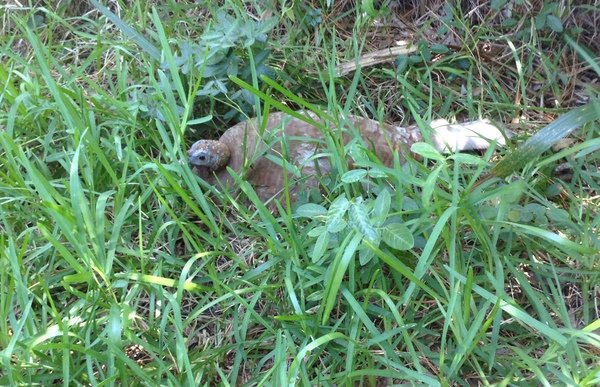
Tall grass is the favorite nest choice for wild and domestic turkeys
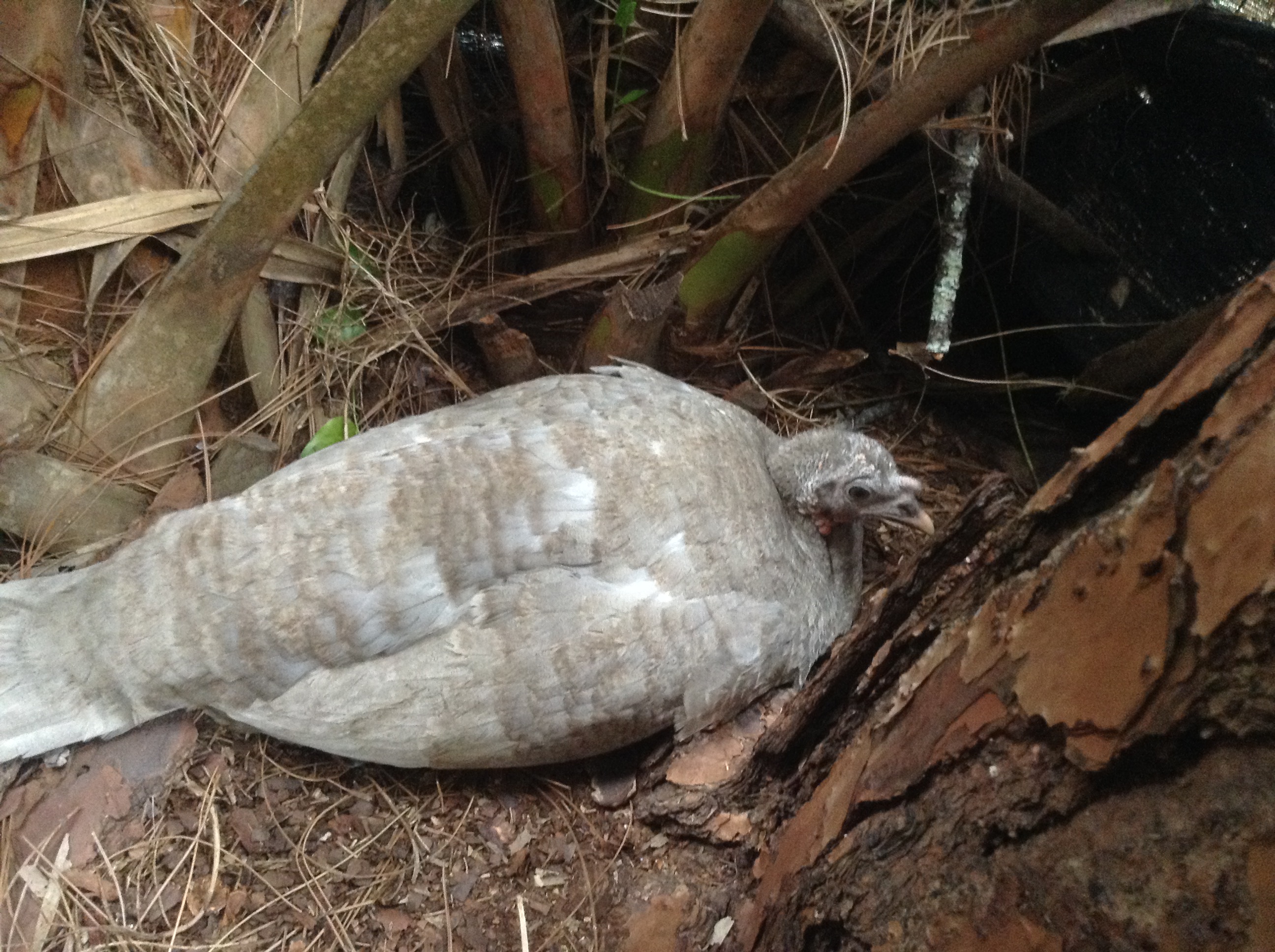
Another favorite nesting spot is at the base of trees
So begins the most dangerous period for the eggs, the free range turkey hen and hatchlings:
14 days or more of laying one egg a day and trusting that the night raiding raccoons and opossums will not discover the tasty eggs; followed by 28 days of the hen setting the eggs, vulnerable to nocturnal predators on the prowl for a turkey dinner.

Scene of a night attack:
The hen was not killed but her injuries were such that I had to lock her up for two weeks. I applied antibiotics to the terrible wound. She recovered to hatch the last nest of the season.

Here in central Florida, the danger to turkeys abound.
We have owls and alligators, hurricanes and wildfires, hunters and eco-tourists, snakes, coyotes, bobcats & occasionally a panther.
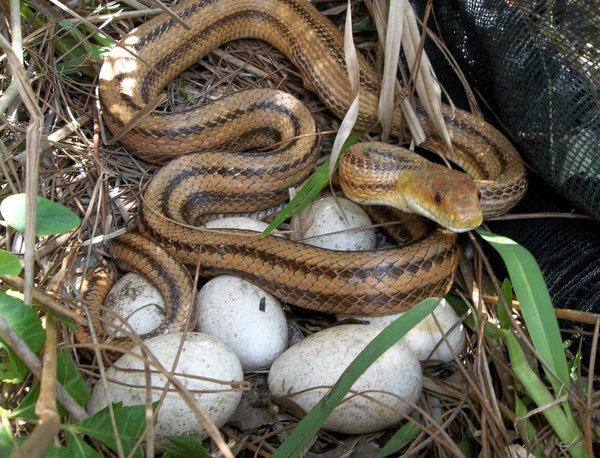
Note the netting I had placed around the eggs to stop raccoons and foxes
(Yellow rat snake was not harmed, only relocated with one turkey egg in its belly)
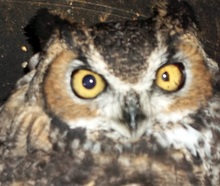






Various dangers to turkeys
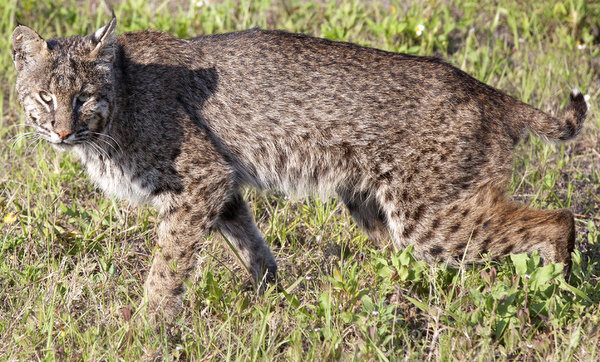
However nothing is more dangerous to the free range hen than the 28 days spent nesting on the ground
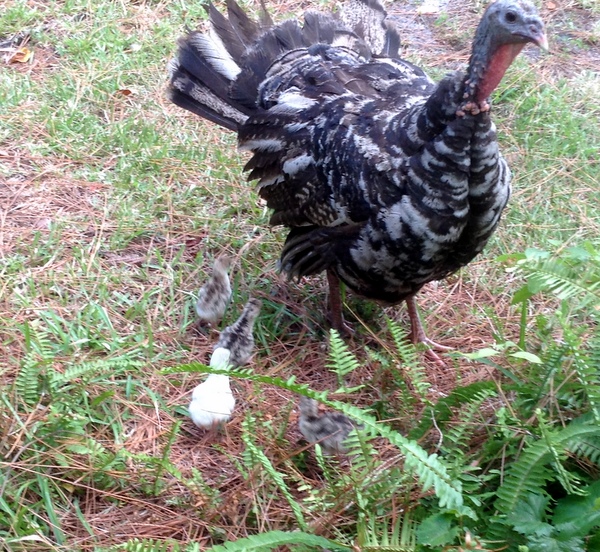
Yet.....This hen walked into the yard with babies.
We did not even realize she had been sitting on a nest
So the most important question: Do you wish to gamble with your turkey hens’ life?
Over and over we have had turkey hens walk into the yard with a dozen babies in tow—a hen that we had no idea was nesting. She had no problems during her 28 days-“healthy hen, healthy poults”.
But we also have had opposite: Nests we were aware of: Eggs raided. Hens killed on the nest. (Normally the predator attacks on day 27---(I will explain the significance later)
Other times the hen will escape with only minor injuries but complete loss of the eggs. Bobcats, foxes and raccoons guilty all.
If you do not wish the gamble: Simply remove the eggs from the nest & donate to a local 4H club or make an omelet. The hen will come to realize the eggs are gone as if a raiding opossum is around.
Or simply lock the hen up after breeding and she begins her "Egg-Yelp calls" a sign she is looking for a new nest. The impregnated turkey hen will not be happy to be placed in a coop-- to say the least. However after she lays 5-6 eggs in the pen/coop, you can open the door and she will continue to return to lay & sit on the location forced upon her.
Some fake eggs in a hidden corner will help to convince her of the new nest location.
Choose to chance Free Range nesting?
There are some tasks you can do to improve her odds of surviving.
First locate the nest (never an easy task) occasionally you can follow the turkey as she does her secretive stroll or egg yelp. Note: she will constantly look back to see if she is being followed.
Instinct drives the impregnated hen to choose a nest location based upon what has succeeded since the Miocene epoch--preference is to avoid deep forests but seek the forest edge or open fields where escape is easier.
The heritage turkey has a distinct preference for “edges”-fence line, house shrubbery, road edge & base of trees. As mentioned on the previous page-- you do not have to search an entire wooded lot-only the edge-line.
As you search, anticipate that the hen has been active; in other words that she may have laid multiple eggs before you discover the nest (Once the nest site has been selected & scratched out, the hen will lay between 8 & 18 eggs.)
During the egg laying process the hen may partially cover the eggs depending on the individual bird.
If there are two hens laying at the same time, often the hens will share one nest and both hens will eventually sit the nest together, defend the nest from predators and also raise the poults together. Their cooperation is not always easy, depending upon each hen’s status in the flock. However the two mother concept is a fairly successful concept of raising poults.
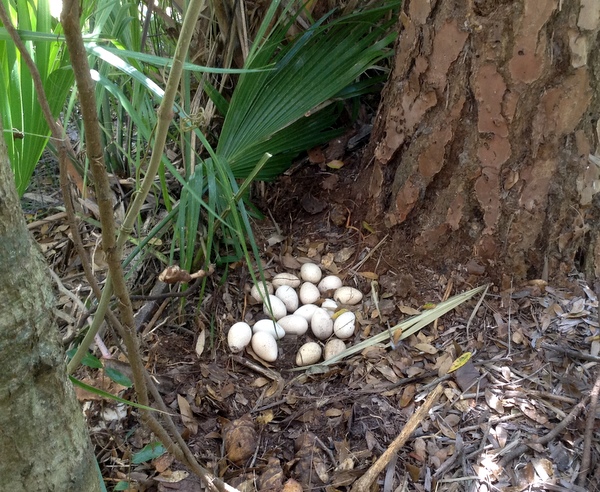
Found it!
If your hen is missing (already setting that is) look for the following signs:
-Half developed poults in crushed eggs –if the egg breaks in the nest, the hen will fly the deceased bird far away from her nest. Read the turkey miracles where one of these crushed & dumped poults survived!
-Larger than normal poop piles: When the hen sets on eggs, she holds her waste inside and voids it in one large pile-normally around a water bucket. We provide a kiddie pool just for the nesting hens to cool off in. (They often step into the pool & enjoy the water. I believe it is an instinct that the nesting hens prefer to drop their waste in the pool! –Most of the time, we can know exactly how many hens are nesting by the amount of waste piles in the pool.
-Broken eggs- the predators or even your dog may already be feasting on eggs.
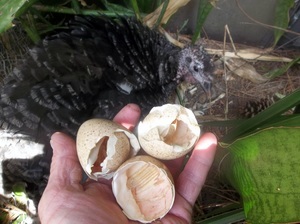
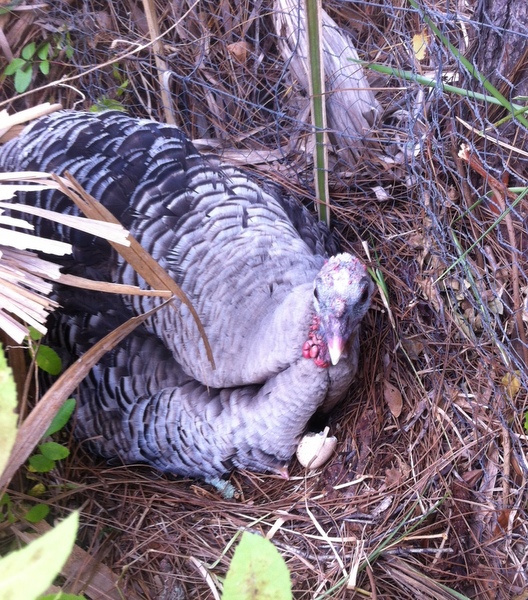
Broken egg shells: a sign of a nocturnal raider or perhaps a poult has hatched!
(no feathers to indicate a fight, so a baby?)
FYI: During the 28 days she will leave the nest once a day for approximately 30 minutes. Priority obligation usually is as follows: Dust bathe, drink, eliminate waste and eat.-Not always in that order, but the dust bathing seems to have priority then the pool.
Some first year hens (first time on the nest), ---we have to force them get off the nest to eat and drink.

We have well over a dozen water containers filled with clean water
Yet the nesting hen seems to prefer a Pool.
Collect some Eggs?
In order to assure hatching success: we will collect some of the eggs and store safely, to be returned to the nest once the hen or hens begins the sitting process. The purpose of collecting some of the eggs is to prevent a night raider from eating all the eggs in one fell swoop.
However if the eggs you left out are missing in the morning......
Construct a Protective fence around the nest?
Often I will have to set up two fences
** The first easy fence is to keep our egg sucking Irish Wolfhounds out of the nest. This is for the laying phase only. My Turkeys and Dogs page
** The second fence when needed will be a true nocturnal barrier constructed to cover all sides.
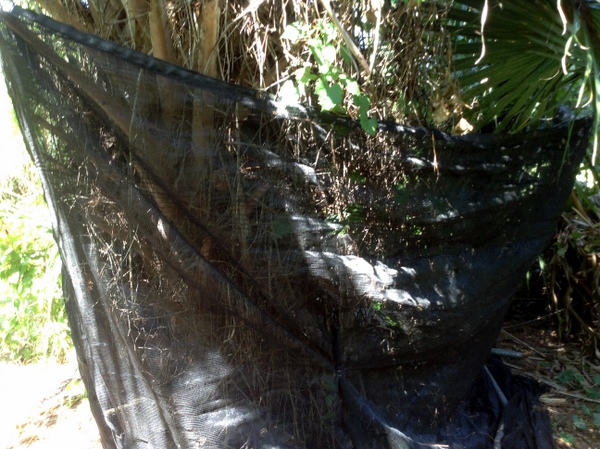
When the turkeys are nesting away from the house, I hang a net around the nest 5-10 feet high. Bobcats around? I will put a top on the net.
At some point upon discovery of every nest, I will investigate the possibility (difficulty) of constructing a protective fence around the nest. This “temporary pen” (for six weeks) will have to keep out nocturnal bobcats, raccoons and dogs. The temporary pen must have a wide door or gate that can be shut at sundown and opened near or at sunrise. Ideally the pen should be set up in the time frame to protect the two weeks when the eggs are unguarded, but most importantly when the hen begins to spend her nights on the ground heating her eggs. The door or gate has to be situated in a location that will not hinder the bird while laying or when sitting to exist and return to eat.
If there are bobcats or overly eager raccoons in the area, a wire or netting covering (top) will be required.
One year I set up a 10' tall net around the nest, only to have a bobcat easily climb down the pine tree and kill the hen. The eggs were saved as the cat had no interest in eggs.
Sometimes if the hen is nesting in the neighbors yard, I may just take all the eggs and lock the hen up for a day or two instead of attempting to build a night time safe haven.
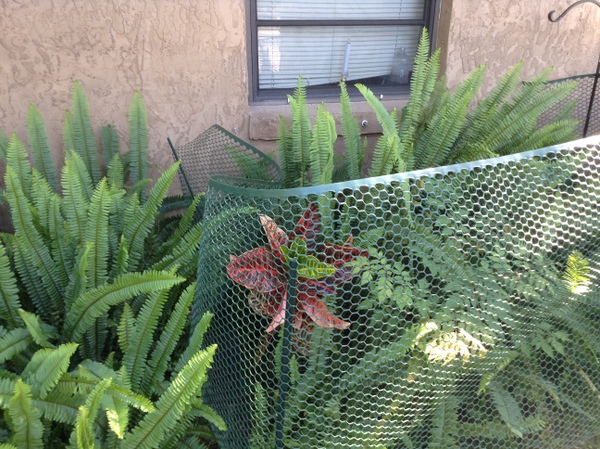
Shorter net when the birds are nesting near the house
Well in the above picture: I created a temporary "dog proof fence" but not yet a night critter proof fence. The result was last night losing 7 out of 10 eggs on this particular nest.
I set a box trap--my guess is it is an opossum.
Will move the remaining eggs at night and place them in the nest at dawn -at least until I finish a raid proof barrier.
In locations that seem to be "favorite spots" we have constructed permanent protective roofed cages & it is a simple matter of shutting the door at sundown.---And we blow out a sigh of relief if the hen chooses the secure spot and it is early spring & bobcats are stalking the roosts. Two hens are currently laying in the permanent cage--To them it is just a shady hidden spot.
Attempt to move the hen and eggs to a new location?
Move the hen at night and this was put to test when I had to relocate TWO hens during Hurricane Irma. Moving at night worked! Details are on the Irma page, but for success I needed: to pre-heat the incubator, just in case of a problem. Two fake eggs and a flashlight.
YouTube (short) videos of me moving a turkey hen from a nest along the road to in indoor cage.
Move turkey hen Recap: Worked fine!
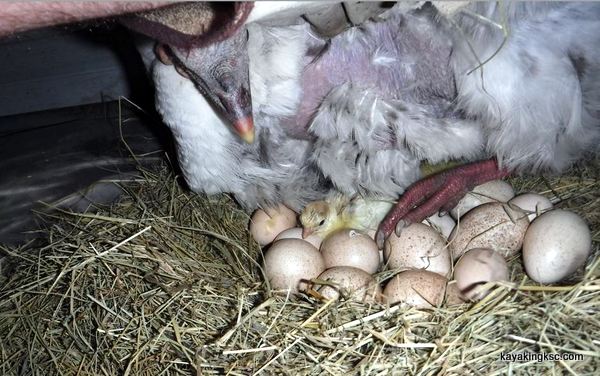
The reward?

Return HOME from Turkey Nesting Survivability
Contact us at: Clovis636@AOL.com

My next book, available on Amazon, February 2025
Eastern Missouri, a little radioactive waste and a possible ghost, what could go wrong?
Do you need the perfect gift?
For pet lovers around the globe, "It's a Matter of Luck" is a collection of heart warming stories of horse rescues from the slaughterhouse.
Available on Amazon:
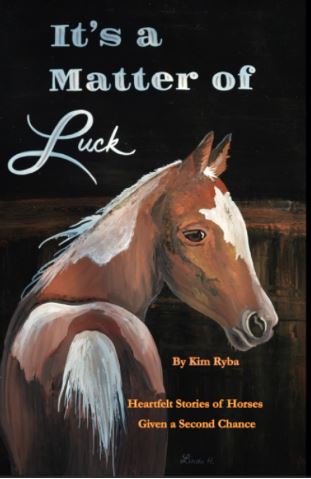
It's a Matter of Luck: Inspirational, Heartfelt Stories of Horses Given a Second Chance.
by Kim Ryba & Lina T. Lindgren
Warning: This book may cause your eyes to water -in a good way. (speaking from experience after reading it)
Please give Kim and Lina a heartfelt review on Amazon!

Author Bruce Ryba at Kennedy Space Center Launch Pad 39B & Artemis 1. "We are going to the Moon!"
Author's discussion (that's me) on You Tube of a book review on Amazon
My Facebook page Pet Turkeys You can always check in and say hello!
For the video versions of information, please check out my YouTube Channel (Turkeys, KSC, Flintknapping, dive stories etc.)
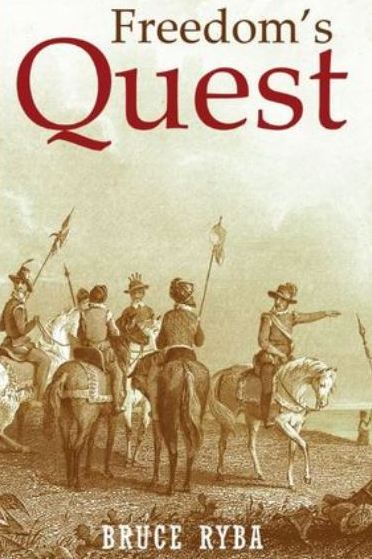
Book One of Florida History:
Freedoms Quest Struggle for the Northern Frontier and lost tales of old Florida
Fiction & language warning.
Available on Amazon
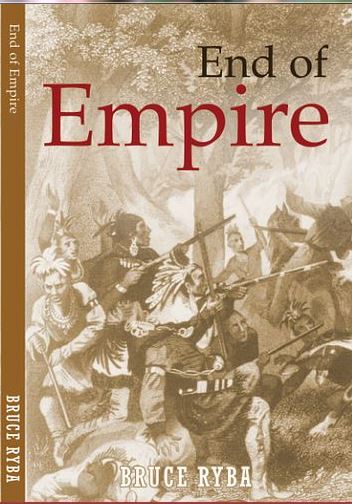
Desperate times call for bold action.
In a desperate move to retain Florida and protect the treasure-laden galleons on their dangerous return journey to Europe, the King of Spain issues a royal decree offering refuge to all English slaves who escape Florida and pick up a musket to defend the coquina walls of Saint Augustine.
In another bold gamble, the King offers refuge to the dissatisfied Indian nations of the southeast who will take up arms against the English.
Clans, traumatized by war and disease, cross the Spanish Frontier to settle the cattle-rich land and burned missions of Florida.
Follow the descendants of the conquistador Louis Castillo in remote Spanish Florida, a wildland swept by diseases, hurricanes, and northern invasions.
Book Two: Available on Amazon

